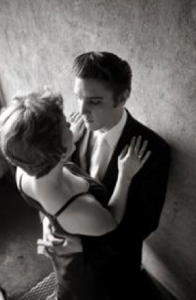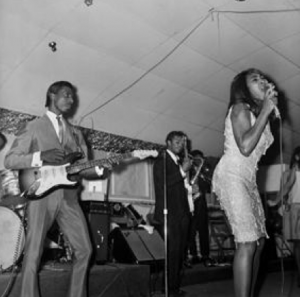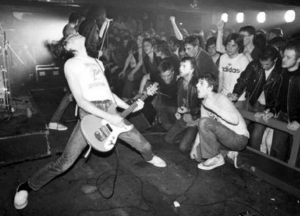 When one thinks about rock photography, the first image that comes to mind is Annie Liebowitz and her early years on the road for Rolling Stone magazine. But there is so much more to the story. In The Annenberg Space for Photography‘s new show, Who Shot Rock & Roll, introduces the pioneers of the field and outlines how closely the musicians and photographers worked to create the attitude and image of rock. With images that date back to a teenage Elvis, a fabulous documentary about the relationships between the show’s featured photographers and their subjects, and fun behind-the-scenes stories about how famous images were captured, this show goes on the MUST list for the summer — that is, for those old enough to handle some occasional R-rated imagery.
When one thinks about rock photography, the first image that comes to mind is Annie Liebowitz and her early years on the road for Rolling Stone magazine. But there is so much more to the story. In The Annenberg Space for Photography‘s new show, Who Shot Rock & Roll, introduces the pioneers of the field and outlines how closely the musicians and photographers worked to create the attitude and image of rock. With images that date back to a teenage Elvis, a fabulous documentary about the relationships between the show’s featured photographers and their subjects, and fun behind-the-scenes stories about how famous images were captured, this show goes on the MUST list for the summer — that is, for those old enough to handle some occasional R-rated imagery.
Spoiler Alert: It is rock and roll, after all… so expect to see some drug use, nudity, profanity, sexual content and violence.
Our favorite part of the experience was watching the documentary produced by the Annenberg which expands from the images on the wall to the stories about the photographers and their subjects. It’s integral to the exhibit, and I think any teenager would really get a kick out of learning about how the camera helped shape the image of rock — from Elvis right on up until punk rock and the moshpit. The film shows on dueling screens in the middle of the exhibit and features exhibit photographers Ed Colver, Henry Diltz, Jill Furmanovsky, Lynn Goldsmith, Bob Gruen, Norman Seeff, Mark Seliger and Guy Webster. The film include appearances by recording artists such as Alice Cooper and Henry Rollins, as well as rock photography über-collector Michael Ochs, Grammy-winning album cover designer Gary Burden and guest curator and author Gail Buckland.
In the early days, those with cameras hung around guys playing guitars and who knew who would be famous? One rocker turned into a great photographer himself (Henry Diltz). Others, you can tell, were just happy to be in the room and hanging with the musicians. Over the years, these trusted comrades in arms were rewarded with ongoing work, not to mention bragging rights to some of the most memorable images in the world. John Lennon on a NY rooftop with a New York tee shirt. The Mamas and the Papas in the bathtub (watch the film for this shot’s hilarious back-story), and Linda McCartney’s early shots of the Beatles.
 How to Talk with your Kids about the Art: Walking into the Space, you’re confronted with a wall full covered in a familiar sight to some: record covers. Remember staring at those as you perused the lyrics and liner notes, obsessively eager for any detail about the artists? Try explaining that to the post-MTV generation! Kids today (did I really just say that?!) can’t imagine not knowing every last detail about a rock star’s life. Which is a gateway to the conversation about how integral the photographers were to the emergent images of the artist. When all the consumer had was a single image to sell the album, it’s easy to see why a great photo was needed to convey a sense of the musician’s personality, the mood of the album.
How to Talk with your Kids about the Art: Walking into the Space, you’re confronted with a wall full covered in a familiar sight to some: record covers. Remember staring at those as you perused the lyrics and liner notes, obsessively eager for any detail about the artists? Try explaining that to the post-MTV generation! Kids today (did I really just say that?!) can’t imagine not knowing every last detail about a rock star’s life. Which is a gateway to the conversation about how integral the photographers were to the emergent images of the artist. When all the consumer had was a single image to sell the album, it’s easy to see why a great photo was needed to convey a sense of the musician’s personality, the mood of the album.
As the years passed, the musicians learned how to use the camera to promote an image (think Madonna, Debby Harry and Alice Cooper). And as photography became more sophisticated, the artistry of the rock photo changed with it. But at the end of the day it’s just a larger-than-life rock star and a gal (or guy) with a camera. And, you have to ask yourself: which came first – the attitude or the camera?
Between now and September, you can attend a lectures by the photographers, part of the Annenberg’s IRIS Nights Lecture series. Click here for a list of the lectures.
KRCW and the Annenberg Space for Photography have organized a live music series in July, which will be free and open to the public.
Aretha Franklin, Possibly at Hammersmith Odeon, London, August 1970 Barrie Wentzell Photography
Elvis Whispers Softly, 1956 © Alfred Wertheimer, The Wertheimer Collection
The Ramones at Eric’s Club, Liverpool, England, May 1977 Courtesy of Ian Dickson/www.late20thcenturyboy.com


